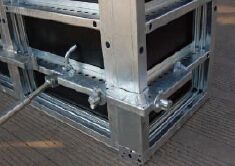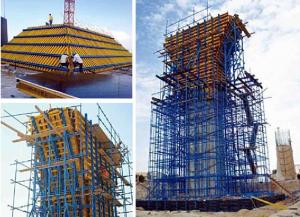Steel-frame formwork for corner
- Loading Port:
- China Main Port
- Payment Terms:
- TT OR LC
- Min Order Qty:
- -
- Supply Capability:
- -
OKorder Service Pledge
OKorder Financial Service
You Might Also Like
Steel-frame Formwork SF-140
Characteristics:
◆ Few parts for fast forming.
◆ Max. Concrete pressure: 80KN/m2.
◆ Hot-dip galvanized steel frame.
◆ The thickness of plywood is 18mm & the panel is 14cm.
◆ Compatibility with Hunnebeck Manto system due to similar edge profile.
System Details & Application:
◆ Neat joint and fast assembling with aligning panel clamp.
◆ Flexible panel arrangement and height extension.
◆ The selection of panels.
◆ Kinds of panel connectors.
◆ Corner clamp application.
◆ Length adjustment application.
◆ Height adjustment & aligning strut.
◆ Walkway bracket & platform.



- Q: How does steel formwork prevent concrete segregation during pouring?
- To prevent concrete segregation during pouring, steel formwork offers a rigid and stable structure that securely holds the concrete in place. The steel panels are engineered to possess strength and durability, guaranteeing that they maintain their shape and do not bend or flex under the weight and pressure of the concrete. This effectively prevents the concrete from separating and segregating, an issue that arises when the formwork lacks sturdiness. Moreover, steel formwork is designed with tight connections and joints, effectively reducing the chances of any leakage. This is crucial because if water from the concrete mixture leaks out, it can lead to the separation and settling of aggregates, causing segregation. Therefore, the tight connections and joints contribute to maintaining the desired shape and dimensions of the concrete structure. Additionally, steel formwork is often treated or coated to prevent any chemical reactions between the concrete and the steel. This is of utmost importance as such reactions can result in concrete segregation and gradual weakening over time. Through the provision of a strong and stable framework, prevention of leakage, and avoidance of chemical reactions, steel formwork ensures that the concrete mixture remains homogeneous and properly integrated, effectively preventing segregation during pouring.
- Q: What are the common safety precautions when working with steel formwork in high winds?
- Some common safety precautions when working with steel formwork in high winds include securing the formwork properly to prevent it from being blown away or unstable, regularly inspecting the formwork for any damage or weaknesses that may be exacerbated by the wind, using appropriate personal protective equipment (PPE) such as helmets and safety harnesses, and ensuring that workers are trained on how to safely work in high wind conditions. Additionally, it is important to monitor weather conditions and suspend work if winds become too strong to ensure the safety of workers.
- Q: Are there any environmental considerations when using steel formwork?
- Yes, there are several environmental considerations when using steel formwork. Firstly, steel production is energy-intensive and contributes to greenhouse gas emissions. However, steel formwork can be reused multiple times, reducing the need for new materials and minimizing waste generation. Additionally, proper disposal and recycling of steel formwork at the end of its lifespan is important to reduce environmental impact. Overall, while steel formwork has certain environmental drawbacks, its reusability and recyclability make it a more sustainable option compared to other formwork materials.
- Q: How does steel formwork affect the overall constructability of the structure?
- Steel formwork can greatly enhance the constructability of a structure due to its strength, durability, and flexibility. It enables the construction process to be more efficient and precise, allowing for faster assembly and disassembly. The use of steel formwork also ensures consistent and high-quality concrete finishes, reducing the need for subsequent repairs or modifications. Additionally, steel formwork can be easily adapted to different shapes and sizes, enabling the construction of complex structures with ease. Overall, the use of steel formwork positively impacts the overall constructability of a structure by improving productivity, reducing construction time, and enhancing the final outcome.
- Q: How does steel formwork contribute to the overall efficiency of a construction project?
- Steel formwork contributes to the overall efficiency of a construction project by providing a durable and reusable framework for concrete placement. It allows for faster assembly and disassembly compared to traditional wooden formwork, reducing construction time and labor costs. The precision and strength of steel formwork ensure accurate and consistent concrete shapes, resulting in higher quality structures. Additionally, its ability to withstand heavy loads and adverse weather conditions improves construction site productivity and safety.
- Q: What are the different types of formwork spacers used in steel formwork?
- Various types of formwork spacers are commonly utilized in steel formwork. These spacers play a crucial role in maintaining the desired spacing between the formwork and reinforcement, thus ensuring the structural integrity of the concrete structure. Here, we present a range of formwork spacers frequently employed in steel formwork: 1. Plastic Spacers: Due to their lightweight nature, durability, and easy installation, plastic spacers are extensively employed in steel formwork. They are typically crafted from top-notch plastic materials and come in diverse shapes and sizes to accommodate different reinforcement requirements. 2. Steel Spacers: Steel spacers are another prevalent type of formwork spacer used in steel formwork applications. Constructed from high-strength steel, they possess the capacity to withstand heavier loads. Steel spacers prove ideal for heavy-duty applications that necessitate added strength and durability. 3. Rubber Spacers: In steel formwork, rubber spacers are employed to provide a cushioning effect and prevent direct contact between the reinforcement and the formwork. These spacers are suitable for scenarios where vibration or movement is anticipated, as they efficiently absorb shocks and minimize the risk of damage. 4. Concrete Spacers: Concrete spacers primarily find utility in precast concrete applications. Comprised of concrete, they act as support structures, ensuring the correct spacing between the formwork and reinforcement is maintained. Concrete spacers are not only durable and easy to install but also offer exceptional stability during the casting process. 5. Combination Spacers: Combination spacers are versatile in nature, incorporating various materials such as plastic and steel to provide enhanced strength and stability. These spacers are designed to meet specific project requirements and offer a cost-effective solution for various steel formwork applications. To guarantee optimal performance and safety, it is imperative to select the appropriate formwork spacer type based on the project's specific requirements, encompassing load capacity, spacing needs, and environmental conditions. Seeking guidance from a structural engineer or construction professional can ensure the correct selection and installation of formwork spacers.
- Q: Can steel formwork be used for both monolithic and composite structures?
- Indeed, steel formwork is applicable to both monolithic and composite structures. This option is known for its versatility and durability, enabling it to endure the pressures and forces associated with these two types of constructions. For monolithic structures, wherein concrete is poured continuously, steel formwork plays a crucial role in providing the necessary support and containment for the fresh concrete. Its easy assembly and disassembly facilitate the efficient construction of monolithic structures like walls, slabs, and columns. The robustness and rigidity of steel formwork ensure its ability to withstand the weight and pressure of the concrete during pouring and curing. On the other hand, composite structures involve combining various materials, such as steel and concrete, to create a more efficient and sturdy structure. In this case, steel formwork can be employed to provide support for the concrete component while accommodating other materials like steel beams or columns. The adaptability of steel formwork allows for the integration of different materials, making it suitable for constructing composite structures like bridges, high-rise buildings, and industrial facilities. In both scenarios, steel formwork offers several advantages compared to other formwork materials. Its strength and durability guarantee the ability to withstand the pressures and forces exerted during construction, thereby resulting in a safer and more efficient building process. Moreover, steel formwork can be reused multiple times, reducing construction costs and minimizing waste. All in all, steel formwork is a reliable and versatile choice for both monolithic and composite structures.
- Q: Can steel formwork be used for industrial flooring?
- Yes, steel formwork can be used for industrial flooring. Steel formwork is known for its durability and strength, making it suitable for heavy-duty applications such as industrial flooring. It can withstand the weight and pressure exerted by heavy machinery and equipment, providing a stable and sturdy base for industrial operations. Additionally, steel formwork offers the advantage of being reusable, which makes it a cost-effective choice for flooring in industrial settings.
- Q: How does steel formwork affect the overall construction timeline?
- Steel formwork can significantly affect the overall construction timeline in several ways. Firstly, steel formwork is known for its durability and strength, allowing for faster and more efficient construction processes. Unlike traditional timber formwork, steel formwork can be reused multiple times, reducing the time and effort required for dismantling and reassembly. This reusability not only saves time but also minimizes the need for additional materials, thereby reducing construction waste and costs. Additionally, steel formwork provides greater flexibility in terms of design and customization. Its versatility allows for complex shapes and structures to be easily created, reducing the need for extensive modifications or adjustments during the construction process. This flexibility not only saves time but also enhances the overall construction efficiency. Moreover, steel formwork offers quicker curing times for concrete, as it provides better temperature and moisture control. This accelerates the process of concrete setting and reduces the time required for form removal. Consequently, the construction timeline is shortened, enabling subsequent construction activities to commence earlier. Furthermore, steel formwork is known for its high load-bearing capacity, enabling multiple floors to be constructed simultaneously. This parallel construction approach can significantly expedite the construction process, thereby reducing the overall timeline. However, it is important to note that while steel formwork offers numerous advantages, its initial setup and installation may require more time compared to other formwork materials. The steel formwork system needs to be properly aligned and secured, which might take longer than setting up traditional timber formwork. However, this initial time investment is often offset by the time saved during subsequent construction stages. In conclusion, steel formwork can have a positive impact on the overall construction timeline. Its durability, reusability, versatility, quicker curing times, and high load-bearing capacity contribute to faster construction processes, reduced material waste, and increased construction efficiency. Despite the initial setup time, the benefits of steel formwork ultimately result in a more streamlined and accelerated construction timeline.
- Q: What are the typical sheet thicknesses used in steel formwork panels?
- The typical sheet thicknesses used in steel formwork panels vary depending on the specific application and requirements, but they commonly range from 2mm to 6mm.
Send your message to us
Steel-frame formwork for corner
- Loading Port:
- China Main Port
- Payment Terms:
- TT OR LC
- Min Order Qty:
- -
- Supply Capability:
- -
OKorder Service Pledge
OKorder Financial Service
Similar products
Hot products
Hot Searches
Related keywords





















